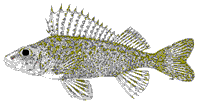Ruffe (Gymnocephalus cernuus)
|
Species and Origin: The ruffe is a small European member of the perch family. Ruffe are primarily bottom feeders, preferring dark environments where they can hide from predators. Ruffe rarely grow bigger than 5 inches, although the sharp spines on their gill covers, dorsal and anal fins make them difficult for larger fish to eat. The ruffe is native to central and eastern Europe. They were introduced into the Duluth harbor within ballast water discharged from ocean-going ships around 1985.
Impacts: In Europe, the ruffe is a pest species in waters it has invaded. Ruffe have shown explosive population growth and have had harmful impacts on native species and functions of aquatic ecosystems. Ruffe grow rapidly and can reproduce in their first year. In the St. Louis River near Duluth, females can lay between 45,000 and 90,000 eggs a year. Populations of yellow perch, emerald shiners, and other forage fish caught in survey trawls have declined significantly as numbers of ruffe have increased in the St. Louis River.
Status: Ruffe have spread from the Duluth harbor to other rivers and bays in western Lake Superior, as well as other Great Lakes. See US map ![]() .
.
Means of spread: Ruffe could be accidentally transported in livewells, bilge water, and bait buckets.
Where to look: They live in lakes and rivers. Anglers should closely examine small fish they catch.
Regulatory Classification: Ruffe are a prohibited invasive species (DNR), which means import, possession, transport, and introduction into the wild is prohibited.
How can you help?
- Do not move ruffe to other waters
- Report infestations to the Minnesota Invasive Species Advisory Council.
Further information:
- Minnesota waters infested with ruffe: Infested Waters List
 (14kb)
(14kb) - Ruffe
ID card (Minnesota Sea Grant)

- Guide to ruffe from the U of MN

- USGS Fact Sheet and Map

 Adult size of the ruffe is 3 to 5 inches. (Drawing courtesy Bell Museum of Natural History.)
Adult size of the ruffe is 3 to 5 inches. (Drawing courtesy Bell Museum of Natural History.)

